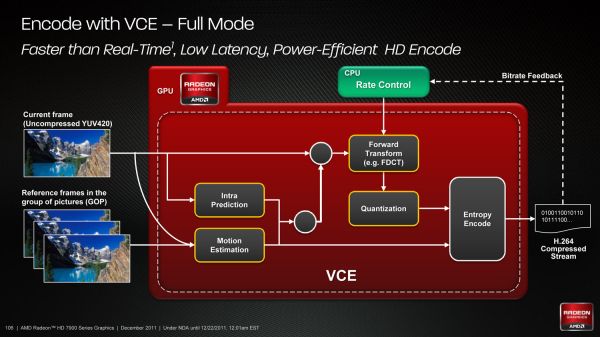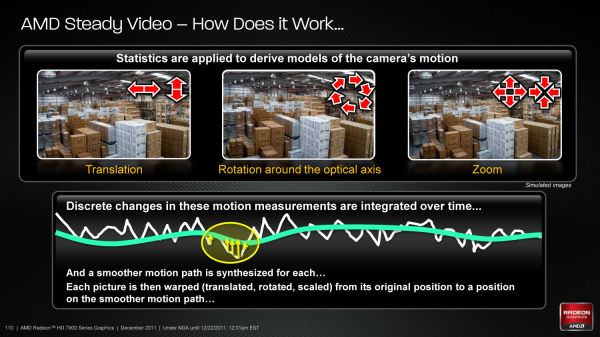AMD Radeon HD 7970 Review: 28nm And Graphics Core Next, Together As One
by Ryan Smith on December 22, 2011 12:00 AM EST- Posted in
- GPUs
- AMD
- Radeon
- ATI
- Radeon HD 7000
Video & Movies: The Video Codec Engine, UVD3, & Steady Video 2.0
When Intel introduced the Sandy Bridge architecture one of their big additions was Quick Sync, their name for their hardware H.264 encoder. By combining a specialized fixed function encoder with some GPU-based processing Intel was able to create a small, highly efficient H.264 encoder that had quality that was as good as or better than AMD and NVIDIA’s GPU based encoders that at the same time was 2x to 4x faster and consumed a fraction of the power. Quick Sync made real-time H.264 encoding practical on even low-power devices, and made GPU encoding redundant at the time. AMD of course isn’t one to sit idle, and they have been hard at work at their own implementation of that technology: the Video Codec Engine (VCE).
The introduction of VCE brings up a very interesting point for discussing the organization of AMD. As both a CPU and a GPU company the line between the two divisions and their technologies often blurs, and Fusion has practically made this mandatory. When AMD wants to implement a feature, is it a GPU feature, a CPU feature, or perhaps it’s both? Intel implemented Quick Sync as a CPU company, but does that mean hardware H.264 encoders are a CPU feature? AMD says no. Hardware H.264 encoders are a GPU feature.
As such VCE is being added to the mix from the GPU side, meaning it shows up first here on the Southern Islands series. Fundamentally VCE is very similar to Quick Sync – it’s based on what you can accomplish with the addition of a fixed function encoder – but AMD takes the concept much further to take full advantage of what the compute side of GCN can do. In “Full Mode” VCE behaves exactly like Quick Sync, in which virtually every step of the H.264 encoding process is handled by fixed function hardware. Just like Quick Sync Full Mode is fast and energy efficient. But it doesn’t make significant use of the rest of the GPU.
Hybrid Mode is where AMD takes things a step further, by throwing the compute resources of the GPU back into the mix. In Hybrid Mode only Entropy Encode is handled by fixed function hardware (this being a highly serial process that was ill suited to a GPU) with all the other steps being handled by the flexible hardware of the GPU. The end goal of Hybrid Mode is that as these other steps are well suited to being done on a GPU, Hybrid Mode will be much faster than even the highly optimized fixed function hardware of Full Mode. Full Mode is already faster than real time – Hybrid Mode should be faster yet.
With VCE AMD is also targeting Quick Sync’s weaknesses regardless of the mode used. Quick Sync has limited tuning capabilities which impacts the quality of the resulting encode. AMD is going to offer more tuning capabilities to allow for a wider range of compression quality. We don’t expect that it will be up to the quality standards of X264 and other pure-software encoders that can generate archival quality encodes, but if AMD is right it should be closer to archival quality than Quick Sync was.
The catch right now is that VCE is so new that we can’t test it. The hardware is there and we’re told it works, but the software support for it is lacking as none of AMD’s partners have added support for it yet. On the positive side this means we’ll be able to test it in-depth once the software is ready as opposed to quickly testing it in time for this review, however the downside is that we cannot comment on the speed or quality at this time. Though with the 7970 not launching until next year, there’s time for software support to be worked out before the first Southern Islands card ever goes on sale.
Moving on, while encoding has been significantly overhauled decoding will remain largely the same. AMD doesn’t refer to the Universal Video Decoder on Tahiti as UVD3, but the specifications match UVD3 as we’ve seen on Cayman so we believe it to be the same decoder. The quality may have been slightly improved as AMD is telling us they’ve scored 200 on HQV 2.0 – the last time we scored them they were at 197 – but HQV is a partially subjective benchmark.
Finally, with Southern Islands AMD is introducing Steady Video 2.0, thesuccessor to Steady Video that was introduced with the Llano APU last year. Steady Video 2.0 adds support for interlaced and letter/pillar boxed content, along with a general increase in the effectiveness of the steadying effect. What makes this particularly interesting is that Steady Video implements a new GCN architecture instruction, Quad Sum of Absolute Differences (QSAD), which combines regular SAD operations with alignment operations into a single instruction. As a result AMD can now execute SADs at a much higher rate so long as they can be organized into QSADs, which is one of the principle reasons that AMD was able to improve Steady Video as it’s a SAD-heavy operation. QSAD extends to more than just Steady Video (AMD noted that it’s also good for other image analysis operations), but Steady Video is going to be the premiere use for it.












292 Comments
View All Comments
haukionkannel - Thursday, December 22, 2011 - link
Well, 7970 and other GCN based new cards are not so much driver depended as those older radeons. So the improvements are not going to be so great, but surely there will be some! So the gap between 580 or 6970 vs 7970 is going to be wider, but do not expect as big steps as 6970 got via new sets of drivers.Ryan Smith - Thursday, December 22, 2011 - link
This is actually an excellent point. Drivers will still play a big part in performance, but with GCN the shader compiler in particular is now no longer the end all and be all of shader performance as the CUs can do their own scheduling.CeriseCogburn - Thursday, March 8, 2012 - link
I hate to say it but once you implement a 10% IQ cheat, it's though to do it again and get away with it again in stock drivers.I see the 797x has finally got something to control the excessive shimmering... that's about 5 years of fail finally contained...that I've more or less been told to ignore.... until the 100+ gig zip download here... to prove amd has at least finally dealt with one IQ epic fail... (of course all the reviewers claim there are no differences all the time - after pointing out the 10% cheat, then forgetting about it, having the shimmer, then "not noticing it in game" - etc).
I'm just GLAD amd finally did something about that particular one of their problems.
Halleluiah !
Now some PhysX (fine bullet or open cl but for pete sakes nvidia is also ahead on both of those!) and AA working even when cranking it to 4X plus would be great... hopefully their new arch CAN DO.
If I get a couple 7970's am I going to regret it is my question - how much still doesn't work and or is inferior to nvidia... I guess I'll learn to ignore it all.
IceDread - Thursday, December 22, 2011 - link
It's a good card, but for me it's not worth it to upgrade from a 5970 to a 7970. Looks like that would be about the same performance.Scali - Thursday, December 22, 2011 - link
This is exactly the reason why I made Endless City available for Radeons:http://scalibq.wordpress.com/2010/11/25/running-nv...
Could you run it and give some framerate numbers with FRAPS or such?
Boissez - Thursday, December 22, 2011 - link
What many seem to be missing is that it is actually CHEAPER than the current street prices on the 3GB-equiped GTX 580. IOW it offers superior performance, features, thermals, etc. at a lower price than current gen at a lower price.What AMD should do is get a 1.5 GB model out @450$ ASAP.
SlyNine - Thursday, December 22, 2011 - link
Looks like I'll be sticking with my 5870. I upgraded from 2 8800GT's ( that in SLI never functioned quite right because they were hitting over 100C ever with after market HSF) and enjoyed over 2x the performance.When I upgraded from a 1900XT to the 8800GT's same thing, 800XT-1900XT, 9700pro - 800XT, 4200(nvidia)-9700pro. The list goes on to my first Geforce 256 card.
Whats the point, My 5870 is 2! generations behind the 7970 yet this would be the worst $per increase in performance yet. Bummer I really want something to drive a new 120hz monitor, if I ever get one. But then thats kinda dependent on whether or not a single GPU can push it.
Finally - Thursday, December 22, 2011 - link
Since when do top-of-the-line cards give you the best FPS/$?For the last few months the HD6870+HD6850 were leading all those comparisons by quite some margin. The DH7970 will not change that.
SlyNine - Thursday, December 22, 2011 - link
If you read my post, you will notice that I'm compairing it to the improvments I have paid for in the past.40-60% Better than a 2 YO 5870 Is much worse than I have seen so far. Considering that its not just one generation but 2 generations beyond and for 500+$ to boot. This is the worst upgrade for the cost I have seen.....
SlyNine - Thursday, December 22, 2011 - link
The 6870 would not lead the cost per upgrade in performance at all, It would be in the negitives for me.